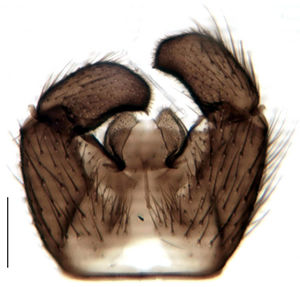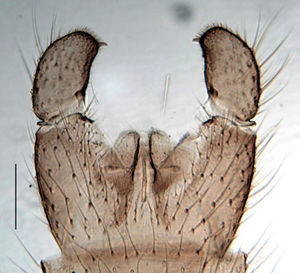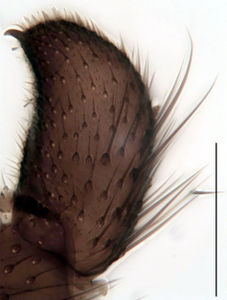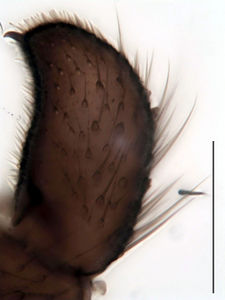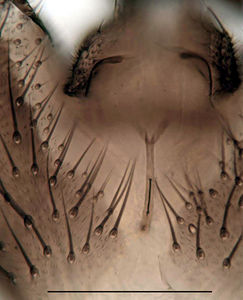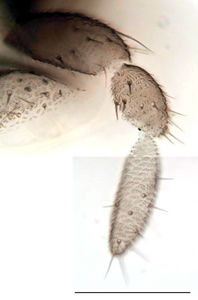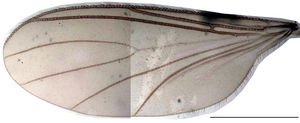Trichosiopsis subviatica
Ordo: Diptera
Familia: Sciaridae
Genus: Trichosiopsis
Name
Trichosiopsis subviatica Mohrig & Menzel, 1997 – Wikispecies link – ZooBank link
- Leptosciarella (Leptosciarella) subviatica Mohrig & Menzel, 1997[1]: 77. fig. 25
- Sciara elongata Winnertz, 1867[2]: 49
- Leptosciarella senex Komarova, 2016[3]: 200, fig. 2
Type material
Holotype: ♂, in PWMP, leg. Gusakova, 27.04.1974
Type locality
Russia, Khabarovsk region, Nature Reserve Khekhtsyr
Other material studied
France: 1 ♂, Marais de Lavours, prairie, Malaise trap, Withers, 21.-30.06.2009; Germany: 1 ♂, Baden-Württemberg, Belchen, Malaise trap, Doczkal, 7.-28.05.2003, PKHH 5031; 1 ♂, Malsch, Heckelbachklamm, Malaise trap, Doczkal, 16.9.-08.01.2004, PASS 59; 1 ♂, Bavaria, Lindau, forest at shore of Lake Constance, sweep netting, Heller, 27.05.2004, PKHH 4208; 1 ♂, North-Rhine-Westphalia, Cologne, district Dünnwald, Malaise trap, Franzen, 9.-16.05.1989, PKHH 1241; 1 ♂, Cologne, district Poll, garden, Malaise trap, Franzen, 10.-17.04.1990, PKHH 2952; 1 ♂, 24.4.-01.05.1990, PKHH 2923; 1 ♂, 29.5.-05.06.1990, PKHH 2950; 1 ♂, 17.-24.07.1990, PKHH 2965; 1 ♂ 1 ♀, 28.8.-04.09.1990, PKHH 2969; 1 ♂, 14.-21.05.2002, PKHH 4262; 2 ♂, 21.-28.05.2002, PKHH 4264; 1 ♂, 20.-27.08.2002, ZSMC 2051; 1 ♂, Krefeld, Winnertz, ZFMK 26 [Holotype of Sciara elongata Winnertz, 1867]; 1 ♂, Rhineland-Palatinate, Gönnersdorf, Eifel, orchard, Malaise trap, Cölln, 30.4.-07.05.1994, PKHH 1901; 5 ♂, Kirchheimbolanden, Nature Reserve Albertskreuz, Malaise trap, Doczkal, 23.5.-07.06.2002, PKHH 4885/4888/4889/4892; 1 ♂, Schleswig-Holstein, Flensburg, Marienhölzung, forest, Malaise trap, Barkemeyer, 17.-24.05.1996, PKHH 2054; 1 ♂, Heikendorf, garden, Malaise trap, Heller, 19.-27.04.1997, PKHH 2330; 1 ♂, 22.-28.06.1997, PKHH 2460; 1 ♂, 10.05.1991, PKHH 21; 1 ♂, Kiel University, garden, Malaise trap, Heller, 5.-12.05.1995, PKHH 1015; 2 ♂, Wankendorf, old beech stump, photoeclector, Warning, 22.5.-05.06.1989, PHKK 8; 1 ♂, Thuringia, Hainich National Park, mixed forest at Thiemsburg, sweep netting, Heller, 18.06.2005, PKHH 4359 [as Leptosciarella rejecta (part.) in Menzel & Heller (2006[4]; 55)]; Hungary: Heves, Szilvásvarad, Bükki Nemzeti Park, sweep netting, Rulik, 22.05.1998, PWMP 4032 [as Leptosciarella rejecta (part.) in Rulik et al. (2001[5]: 241)]; Russia: 1 ♂, Altay Region, Artybash, pine and birch forest, sweep netting, Heller, 01.07.2005, PKHH 4426; 1 ♂, Malaise trap, Komarova, 01.-04.07.2005, PKHH 4684; Sweden: 14 ♂, Östergötland, Omberg, Boskogsreservatet Omberg: beech forest, Malaise trap, Swedish Malaise Trap Project, 28.5.-05.07.2005, NHRS 1496-1501, 1584-1587; PKHH 6052; 3 ♂, Skåne, Simrishamn, Stenshuvud National Park: Svabeholmsskog, hornbeam forest, Malaise trap, Swedish Malaise Trap Project, 22.5.-20.06.2005, PKHH 7230, 7243, 7256; 1 ♂, Södermannland, Södertälje, Tullgarns näs, Rävsalaviken, mixed forest next to pasture, Malaise trap, Swedish Malaise Trap Project, 3.7.-19.08.2004, PKHH 7475; 2 ♂, Uppland, Biskops-Arnö, northern beach, elm grove, Malaise trap, Swedish Malaise Trap Project, 20.6.-18.07.2005, PKHH 7376; NHRS 4551; Switzerland: 1 ♂, Zurich, Sihlwald, window trap, Schiegg, 24.4.-11.05.1996, PKHH 1545 [in Schiegg et al. (1999: 80)[6] as Leptosciarella yerburyi part.]; 1 ♂, 24.05-19.06-1996 PKHH 2421.
Description (male)
See under the subspecies.
Diagnosis
Trichosiopsis subviatica is in its typical form a very dark and strongly setose species. It is characterized by a quite short and slightly thickened first palpomere and a strongly setose r-m-vein. The shape of the dorsally equally rounded gonostyli may resembles those of Trichosiopsis viatica, but often the gonostyli are more slender. The species can also be separated by the darker colour of legs, thorax and halteres and by the dark setae on the fore coxae and also the longer ejaculatory apodeme. The hypopygium bears some strong basal setae, which make Tr. subviatica appear similar to Trichosiopsis subpilosa, which otherwise is nearly identical, but has the strong setae on conspicuous lobe-like extensions.
DNA Barcoding
The COI sequence is assigned to BIN BOLD:ACK0022 (average distance 1.05%, max. 2.25%, n=17, K2P: 9.79%).
Etymology
lat. sub- = under, beneath; lat. viaticus = travelling. The name makes reference to the similarity to Leptosciarella viatica.
Ecology
In contrast to Tr. viatica Trichosiopsis subviatica is apparently not restricted to dead wood as it is frequently found in urban ecosystems and gardens.
Discussion
Trichosiopsis subviatica has not been recognized as a distinct species for a long time, although it is quite abundant and widespread. The synonymy with Sciara elongata Winnertz, 1867 is confirmed by comparison of the hypopygium of the lectotype (Fig. 4) with recent material. The long and slender aedeagus, the dorsally evenly rounded gonostyli and the setae at the hypopygial base are typical for Tr. subviatica and not for Tr. rejecta as which it was identified by Menzel & Mohrig (1997: 63[1]). Tr. rejecta has still longer setae at the hypopygial base. The remaining body parts of the lectotype specimen are lost. Despite of the new synonymy the younger name subviatica remains valid, because Sciara elongata Winnertz, 1867 is a primary junior honomym of Sciara elongata Bouché, 1834.
Another synonym of this species was found to be Leptosciarella senex, which was described by Komarova from the Altai Region in Russia. The holotype was not available for study. But two specimens from the same region are included among the studied material, which perfectly agree with the German specimens as well as with the holotype of Tr. subviatica.
The species is morphologically very variable, although the known genetic distances are low. It is uncommon for the genus Trichosiopsis, that the morphological variability is more pronounced that the genetical one. At present, all barcoded specimens are assigned to the same BIN, which has a relatively high maximum distance of 2.25%. Comparison of the haplotypes shows a quite clear barcoding gap, but not all intraspecific variability is yet included among the barcoded material. Nevertheless, it seemed appropriate to define morphologically and partly genetically differentiated subspecies.
Distribution
Germany[7], Finland[8], France, Great Britain[9], Hungary, Norway[10], Russia[1], Slovakia[1][11], Sweden[12], Switzerland.
Notes
In prior versions of this Wikispecies page, records for Morocco and Greece were listed. Those specimens, however, proved to belong to different species, so that Tr. subviatica is not yet recorded from these two countries.
Subspecies list
Trichosiopsis subviatica heikendorfensis - Trichosiopsis subviatica hungarica - Trichosiopsis subviatica subelongata - Trichosiopsis subviatica subviatica
Images
|
References
- ↑ 1.0 1.1 1.2 1.3 Mohrig, W.; Menzel, F. 1997: Revision der paläarktischen Arten von Trichosia Winnertz sensu Tuomikoski, 1960 (Diptera, Sciaridae). – Teil II. Gattungen Leptosciarella Tuomikoski, 1960 und Trichodapus gen. nov. Studia dipterologica, 4(1), 41–98.
- ↑ Winnertz, J. 1867: Beitrag zu einer Monographie der Sciarinen. W. Braunmüller, Wien. BHL
- ↑ Komarova, L.A. 2016: A Review of Sciarids of the Genus Leptosciarella Tuomikoski 1960 (Diptera, Sciaridae) in the Altai Fauna, with Description of Three New Species. Zoologicheskyi Zhurnal, 95(2), 196–203. doi: 10.7868/S0044513416020112.
- ↑ Menzel, F.; Heller, K. 2006: Trauermücken (Diptera: Sciaridae) aus dem Nationalpark „Hainich“ (Thüringen) nebst der Beschreibung von Scatopsciara andrei Menzel spec. nov. Studia dipterologica, 13(1), 45–59.
- ↑ Rulik, B.; Mohrig, W.; Jaschhof, M. 2001: Trauermücken (Diptera: Sciaridae) und freilebende Gallmücken (Diptera: Cecidomyiidae: Lestremiinae) aus Ungarn. Mit Bemerkungen zur Corynoptera tridentata-Gruppe. Folia Entomologica Hungarica, 62, 231-245.
- ↑ Schiegg, K.; Obrist, M.; Duelli, P.; Merz, B. et al. 1999: Diptera and Coleoptera collected in the Forest Reserve Sihlwald ZH. Mitteilungen der Schweizerischen Entomologischen Gesellschaft, 72, 289-302.
- ↑ Heller, K. 2004: Eine Bestandsaufnahme der Sciaridae (Diptera) Schleswig-Holsteins mit Ergänzungen und Korrekturen zum bisher bekannten Arteninventar. Faunistisch-Ökologische Mitteilungen, 8, 233–257.
- ↑ Vilkamaa, P.; Heller, K.; Hippa, H. 2013: New species of Sciaridae (Diptera) to the Finnish fauna. Sahlbergia, 19(1–2), 20–29.
- ↑ Menzel, F.; Smith, J.E.; Chandler, P. 2006: The sciarid fauna of the British Isles (Diptera: Sciaridae), including descriptions of six new species. Zoological Journal of the Linnean Society, 146, 1-147. PDF
- ↑ GBIF Trichosiopsis subviatica
- ↑ Rudzinski, H.-G.; Ševčík, J. 2012: Fungus gnats (Diptera: Sciaroidea) of the Gemer region (Central Slovakia): Part 3 – Sciaridae. Časopis Slezského zemského muzea, 61, 143–157.
- ↑ Heller, K.; Vilkamaa, P.; Hippa, H. 2009: An annotated check list of Swedish black fungus gnats (Diptera, Sciaridae). Sahlbergia, 15(1), 23-51.


